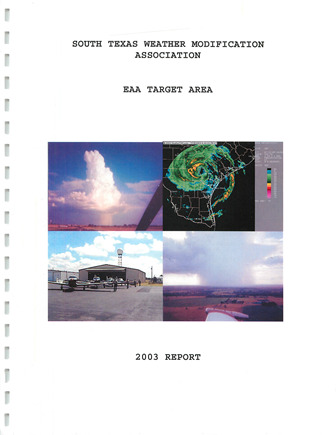South Texas Weather Modification Association EAA Target Area 2003 Report

| Summary |
|
2003 marked the second year of operations for the EAA by the STWMA. One change seen was the extension of the seeding season from September 30th to October 31st. This was done in 2002 as a result of the downtime we experienced due to flooding rains. For 2003, the extension really didn’t make much of a difference, as no seeding was done after September 17th. As was the case in 2002, one plane, N57AA, was stationed at Stinson Field (SSF) in south San Antonio. Two of our pilots, Ron Merks and Mickey Chadwell, were stationed there. They worked along with Jim Transue and Tim Pickens, stationed at Pleasanton, and Larry Dement, stationed at Kenedy. Occasionally the other pilots helped out with seeding in the EAA target area. 2003 turned out to be a much better year for seeding in the EAA target area, with 22 days of seeding, compared with only 8 in 2002. With a record-setting dry spell in May, our first seeding mission did not take place until May 27th. June saw 4 days with seeding, while July ended up being the busiest month, with 8 seeding days. Hurricane Claudette tracked across south Texas on July 15th, bringing heavy rain and high winds to much of the area. Due to a risk of flooding, operations were suspended from the 15th through the 20th to allow for any rains to soak in and flooded rivers to recede. A rare July cold front pushed down into Texas on July 23rd. The front itself stayed north of the area, but a pre-frontal trough did make it through the area, igniting showers and thunderstorms. The busy weather continued into August, with 7 days of seeding taking place. Things quieted down in September, with only two days of seeding. After the middle of the month, there were no more missions for the year. Once the season concluded, Archie Ruiz completed the radar evaluation of the program, and again it appears that seeding produced favorable increases in rainfall. These numbers are presented and discussed on page 36 of this report. For 2004, there will be a dramatic change in the radar data. We have acquired an agreement with WDT, a company based in Oklahoma City. They will be taking the TITAN software, which we currently use in conjunction with our C-band radar, and integrating it into the National Weather Service Doppler radars in New Braunfels, Corpus Christi, and Brackettville. Starting in 2004, our program will use WDT’s software to peruse radar data from the NWS in order to conduct operations. It is an exciting change, since the meteorologist will now have access to many of the algorithms currently used by the NWS. Some of these include, but are not limited to, tornado detection, hail detection, lightning strike display, and future radar, which takes past reflectivities and extrapolates 30-60 minutes into the future to give you a “predicted radar image”. Radial velocity data will also be available, which lets the meteorologist look at the winds within a storm…. 2003 saw more activity weatherwise compared to the previous year, and as such, we saw more cloud seeding missions take place in the EAA target area. Radar analysis showed that seeding effects this year were positive once again…. Overall, the main factor that is evident from comparing the 2002 and 2003 analyses deals with the cloud attributes. The clouds in 2002 were larger, on average, and appeared to contain more water than those in 2003. When looking at the parameter increases alone, 2003 was a more successful year in terms of the apparent effectiveness of seeding. With further work in weather modification in the EAA target area and more analyses, we will get a better understanding of the effects of glaciogenic seeding in south Texas. |
Search for Documents
Advance Search
Explore EAA's Scientific Reports
- All Reports
- Modeling
- Hydrology and Hydrogeology
- History
- Groundwater Recharge, Recharge Zone
- Groundwater Movement
- Geomorphology and Caves
- Weather Modification
- Geology
- Water Use and Conservation
- Geochemistry
- Water Resources Planning and Management
- Floods and Drought
- Water Quality
- Climatology
- Surface Water / Groundwater Relationship
- Biology
- Springs, Groundwater Discharge
- Archaeology
- RZ Protection
- Aquifer Levels
- Remote Sensing
- Precipitation
- Overview Studies
